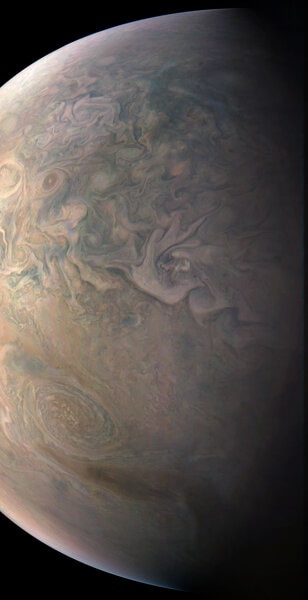Create a free profile to get unlimited access to exclusive videos, sweepstakes, and more!
The Broad Strokes of Jupiter

This post is what Boing Boing calls a “unicorn chaser,” a bit of eye candy to cleanse the brain after a particularly off-putting article. So, after Wednesday’s distressing news, here’s something to make your cerebrum a bit happier.
A new image of Jupiter taken by the Juno spacecraft reveals a fantastic vista that looks like an impressionistic painting. When it took the frames making up this image, Juno was looking down on Jupiter from about 17,000 kilometers above the cloud tops, when the spacecraft was above Jupiter’s northern latitudes.
You can see the intricate play between winds at different latitudes, interacting to create magnificent swirls, vortices, and turbulence in a view wholly different than what we’re used to from Earth. It’s hard to even see the usual banding in the clouds!
To the bottom left is a massive storm, technically called NN-LRS-1 (the North North Temperature Zone Little Red Spot 1). The size of the Earth(!!!), it’s been nicknamed the Little Red Spot—not a bad name, though it’s one of the largest storms on the largest planet in the solar system.
This image was taken on Dec. 11, when Juno was at Perijove 3 (the third time while orbiting Jupiter that it passed close to the planet). The raw data from Juno are available online, and two “citizen scientists,” Gerald Eichstaedt and John Rogers, processed these images to create the lovely shot.
LRS-1 is an anti-cyclone, a region of high pressure with gas swirling around it at speeds faster than a whopping 600 kph. Since it’s in the northern hemisphere (around 40° north latitude) it rotates clockwise—anti-cyclones in the southern hemisphere spin the other way due to the Coriolis effect. It’s not clear why it’s brownish in color, but it’s changed hue over the years, from reddish to brown to off-white. In visible light, like this image, it can sometimes be hard to see against the similarly colored surroundings. It’s actually very bright when observed using a near-infrared filter; this is due to methane clouds capping the storm at high altitudes. Methane preferentially reflects light in the near infrared.
Some jovian storms come and go, forming, growing, then dissipating. Some last far longer. The iconic Great Red Spot (which is in the southern hemisphere, along with its pal Oval BA) is at least 400 years old. We’ve only been observing Jupiter for that long, so for all we know the GRS is millennia old, or maybe even more ancient. The LRS is younger; it was first spotted in 1993. It grows by absorbing other storms; in 1998 it merged with three smaller systems that had been observed since the 1930s!
Jupiter is weird. But that’s one reason we keep an eye on it. It’s very different than Earth, but like everything else in the Universe it obeys the same set of physical rules. It spins rapidly, it’s mostly gas, it has immense gravity, it’s cold … all of these come together through the mathematics of physics to make it understandable. And then, by contrast, we understand the Earth better. Our own planet is complex, subtle, robust, delicate … and these all come together to form an environment we must understand. For now, and for the foreseeable future, it’s the only planet we’ve got that we can live on. It’s only by observing Earth and the other planets we have nearby that we can hope to understand our home world well enough to make sure that foreseeable future lasts a long, long time.



























